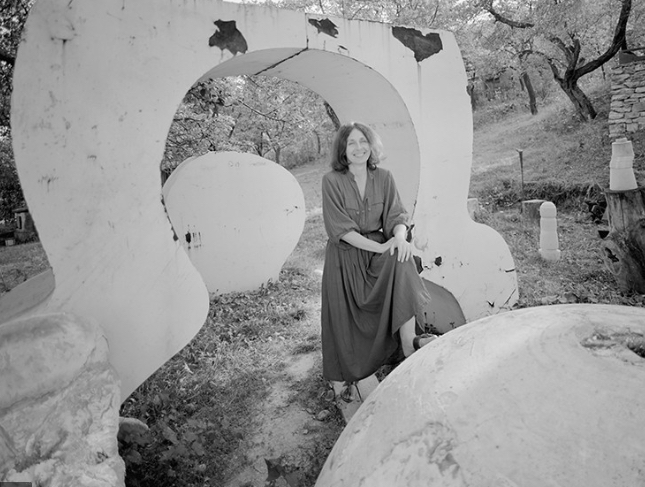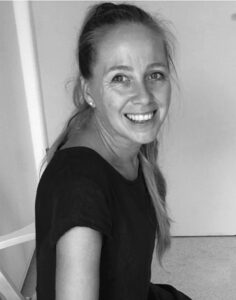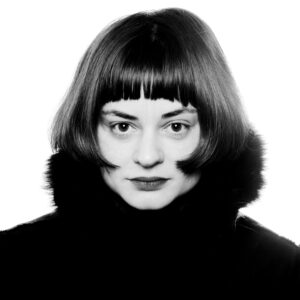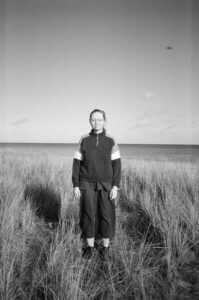Mária Bartuszová

– born 1936, died 1996 – was one of the most prominent representatives of modern sculpture in Slovakia. She graduated from the Academy of Arts, Architecture and Design in Prague (1956—1961), then moved to Košice. For a time, she collaborated with the Club of Concretists (Klub konkretistov), but then she was defined more by biomorphic morphology, with which she has been working since the 1960s. Bartuszová also created haptic sculptures for the blind or constructed more complex installations, which often became the bearers of existential meanings. Most of the works were characterized by a developed sense of materiality, which was most often manifested through the author’s experimental treatment of plaster or plastic. The work of Mária Bartuszová gradually gained recognition not only in the local but also in the international context – at present, her works are represented, e.g., in the collections of the Slovak National Gallery, Centre Pompidou, Kontakt. The Art Collection of Erste Group and Erste Foundation, or Tate Gallery.
Mária Bartuszová was born in 1936 in Prague, where in the years 1956—1961 she also studied ceramics and porcelain at the Academy of Arts, Architecture and Design. Shortly after graduating, she married the sculptor Juraj Bartusz, became a mother, and at the same time moved to the east of Slovakia, where she has worked mainly in the more culturally developed environment of Košice since 1963. From the early stages of her artistic career, she preferred concentrated work in an intentionally chosen seclusion, presenting herself only sporadically in public1.
Compared to the progressive tendencies of the 1960s, Bartuszová’s work was based more on an experimental approach to traditional sculptural techniques, which became the framework of her original thinking about working with space, negative volume, or the physical properties of matter2. The dominant line of her creative endeavour became organically understood abstraction, which gradually gained a definitive preponderance over the episodic construction of works by the principles of geometry (Dandelion Seeds in the Air, 1968-1970). This basic repertoire, consisting of biomorphic shapes and volumes, was developed by Bartuszová during her work in Prague, when she began to deal with the casting of gypsum into elastic materials (such as rubber balloons or condoms). At the same time, the connection of her technological experimentation with the sphere of personal life also manifested itself and was reflected mainly in the creation of works reflecting the author’s own experience with motherhood and female sexuality (Untitled, 1964)3.
Despite many limiting factors of the environment, the work of Maria Bartuszová often responded to the works of authors such as Constantin Brâncuşi, Hans Arp, Luciano Fontana and Henry Moore. Her regular source of information about current art events was not only domestic but also foreign periodicals (especially Flash Art), from which she continued to draw while developing her own artistic research. At the applied level, theoretical texts of a scientific nature (e.g., the article on the butterfly effect of meteorologist Edward Lorenzo) as well as the basic concepts of Zen Buddhism were also stimulating4.
The overall creative focus of Bartuszová was determined by her developed sense of sensuality and processualism, which became evident especially in the thematicization of movement, waves, growth or, conversely, moments leading to extinction (Germination, 1977)5. These artistic qualities were supported by the very choice of a material with provisional qualities, which, thanks to its sensitivity, recorded traces of the author’s physical action on the final structure. During the 1970s, many of Bartuszová’s gestures began to turn into increasingly radical interventions in the material, which eventually resulted in a programmatic destruction of shape integrity, evoking psychodynamically oriented contents.
The transformation of Bartusz’s artistic process in the early 1980s was significantly affected by the change in her environment, which was related to the family’s relocation to a more spacious house. The opportunity to work on larger works, as well as the opportunity to combine plaster more freely with a wider range of natural materials, created an important precursor to her immediately following creative period, the dynamics of which were marked after 1984 by the breakdown of her long-term relationship. From this point on, Bartuszová became characterized by pure ovoid shapes and fragile, shell-like forms, which were increasingly disturbed by violent processes of deformation, perforation or tying (Untitled, 1985—1987), thus at some level referring to the author’s current life situation. Like these strategies, the conflicting forces and volumes present were accentuated by the opening of the basic material structure, thanks to which the internal space, formed primarily by variations of imprints and cavities, also gained in importance (Cavity II., 1987).
Even though during her life she has prepared only three solo exhibitions (the last one in 1988), the work of Mária Bartuszová is becoming the subject of intense interest not just in her homeland but also abroad. Particularly important in this regard was her representation at the XII. Documenta in Kassel (2007), a solo exhibition called Provisional Forms at the Museum of Modern Art in Warsaw (2014-2015), or a retrospective exhibition at the Tate Modern, originally planned for 2020.
The text was written by Lujza Kotočová (2021).
1Compare Vladimíra Büngerová, Sochárky: Výber osobností česko-slovenského sochárstva, Bratislava 2015, p. 44—45; Gabriela Garlatyová, "Lives of the Artists: Maria Bartuszová", see: https://www.tate.org.uk/tate-etc/issue-40-summer-2017/lives-of-the-artists-maria-bartuszova-gabriela -garlatyova.2Vladimír Beskid, Architektura bio-forem: Mária Bartuszová,[in:] "Revue Art", 2007(1), p. 50—53, especially p. 53.
3Gabriela Garlatyová, Touch! The impressed thought of Maria Bartuszová, [in:] Marta Diewańska (ed.), "Maria Bartuszová: Provisional Forms", Warsaw 2015, p. 43—54, especially p. 46.
4Ibidem, p. 45, 53.
5For a presentation of the work by curator of Slovak National Gallery Vladimíra Büngerová, see: https://www.youtube.com/watch?v=YWq92xlgi40.
– narodila sa v roku 1936, zomrela v roku 1996 – patrila k najvýraznejším predstaviteľkám moderného sochárstva na Slovensku. Štúdium absolvovala na Vysokej škole umeleckopriemyslovej v Prahe (1956—1961), následne sa presťahovala do Košíc. Istý čas spolupracovala s Klubom konkretistov, no charakteristickým sa pre ňu stalo biomorfné tvaroslovie, s ktorým pracovala už od 60. rokov. Bartuszová sa venovala taktiež tvorbe haptických plastík pre slepcov či konštruovaniu komplexnejších inštalácií, ktoré sa často stávali nositeľmi existenciálnych významov. Väčšina z diel sa vyznačovala rozvinutým citom pre materialitu, ktorý sa najčastejšie manifestoval skrze autorkino experimentálne zachádzanie so sadrou či plastom. Tvorba Márie Bartuszovej postupne získavala uznanie nielen v miestnom, ale aj v medzinárodnom kontexte – v súčasnoti sú jej diela zastúpené napr. v zbierkach Slovenskej národnej galérie, Centre Pompidou, Kontakt. The Art Collection of Erste Group and Erste Foundation, či Tate Gallery.
Mária Bartuszová sa narodila v roku 1936 v Prahe, v rokoch 1956—1961 tu rovnako absolvovala štúdium keramiky a porcelánu na Vysokej škole umeleckopriemyselnej. Krátko po jeho ukončení sa zosobášila so sochárom Jurajom Bartuszom, stala sa matkou, a zároveň sa presťahovala na východ Slovenska, v rámci ktorého od roku 1963 pôsobila predovšetkým v kultúrne rozvinutejšom prostredí Košíc. Od ranej fázy svojej umeleckej kariéry preferovala sústredenú prácu v intencionálne zvolenom úzadí, verejne vystupovala len sporadicky1.
V porovnaní s progresívnymi tendenciami 60. rokov, tvorba Bartuszovej sa zakladala skôr na experimentálnom prístupe k tradičným sochárskym postupom, ktoré sa stávali rámcom jej originálneho uvažovania o práci s priestorom, negatívnym objemom či fyzikálnymi vlastnosťami hmoty2. Dominantnou líniou jej kreatívneho snaženia sa stala najmä organicky chápaná abstrakcia, ktorá postupne získala definitívnu prevahu nad epizodickým konštruovaním diel prostredníctvom princípov geometrie (Semienka púpavy v povetrí, 1968—1970). Tento základný repertoár, pozostávajúci z biomorfných tvarov a objemov, bol Bartuszovou rozvíjaný už v priebehu jej pražského pôsobenia, kedy sa začala zaoberať odlievaním sadry do elastických materiálov (ako napr. gumové balóny či kondómy). Súčasne s tým sa prejavila taktiež previazanosť jej technologického experimentovania so sférou osobného života, čo sa odrazilo hlavne na vzniku diel reflektujúcich autorkinu vlastnú skúsenosť s materstvom a ženskou sexualitou (Bez názvu, 1964)3.
Navzdory mnohým limitujúcim faktorom prostredia, tvorba Márie Bartuszovej často reagovala na diela autorov akými boli Constantin Brancusi, Hans Arp, Luciano Fontana či Henry Moore. Pravidelným zdrojom informácií o súčasnom umeleckom dianí jej boli nielen domáce, ale aj zahraničné periodiká (najmä Flash Art), z ktorých ďalej čerpala pri rozvíjaní vlastného umeleckého výskumu. V aplikovanej rovine boli pre ňu podnetnými tiež teoretické texty vedeckej povahy (napr. state o motýlom efekte meteorológa Edwarda Lorenza) ako aj základné koncepty zen budhizmu4.
Z hľadiska celkového tvorivého zamerania bol pre Bartuszovú rovnako určujúci jej rozvinutý cit pre zmyslovosť a procesuálnosť, ktorý sa stával zrejmým hlavne v prípade tematizovania pohybu, vlnenia, rastu alebo, naopak, momentov smerujúcich k zániku (Klíčenie, 1977)5. Tieto umelecké kvality podporovala už samotná voľba provizórne pôsobiaceho materiálu, ktorý vďaka svojej citlivosti zaznamenával stopy telesného pôsobenia autorky na konečnú štruktúru. V priebehu 70. rokov sa mnohé Bartuszovej gestá začali premieňať v čoraz radikálnejšie zásahy do východiskovej hmoty, čo napokon vyústilo až do programovej deštrukcie tvarovej integrity, evokujúcej psychodynamické a hlbinne orientované obsahy.
Značný dopad na premenu Bartuszovej umeleckého procesu mala v úvode 80. rokov zmena jej životného prostredia, ktorá súvisela s presťahovaním rodiny do priestrannejšieho domu. Príležitosť pracovať na dielach väčších rozmerov, rovnako ako možnosť slobodnejšie kombinovať sádru so širšou škálou prírodných materiálov, vytvorila dôležitý predstupeň jej bezprostredne nasledujúceho tvorivého obdobia, ktorého dynamika bola po roku 1984 poznamenaná rozpadom jej dlhoročného vzťahu. Od tohto bodu sa pre Bartuszovú stávali charakteristickými čisté ovoidné tvary a krehké, škrupinovité formy, ktoré boli čoraz častejšie narúšané násilne pôsobiacimi procesmi deformácie, perforácie či preväzovania (Bez názvu, 1985—1987), čím tak v určitej rovine odkazovali k aktuálnej životnej situovanosti autorky. Podobne ako tieto stratégie, konfliktne pôsobiacu súvzťažnosť medzi prítomnými silami a objemami zvýrazňovalo aj otváranie základnej hmotnej štruktúry, vďaka čomu na význame získaval tiež vnútorný priestor, tvorený primárne variáciami odtlačkov a dutín (Dutina II., 1987).
Navzdory tomu, že počas svojho života pripravila len tri samostatné výstavy (z toho poslednú v roku 1988), tvorba Márie Bartuszovej sa stáva predmetom intenzívneho záujmu doma aj v zahraničí. Obzvlášť významným bolo v tomto ohľade jej zastúpenie na XII. Documente v Kasseli (2007), samostatná výstava s názvom Provisional Forms v Múzeu moderného umenia vo Varšave (2014—2015), alebo retrospektíva v Tate Modern, ktorá bola pôvodne plánovaná na rok 2020.
Text napísala Lujza Kotočová (2021).
1Porovnaj Vladimíra Büngerová, Sochárky: Výber osobností česko-slovenského sochárstva, Bratislava 2015, s. 44—45; Gabriela Garlatyová, "Lives of the Artists: Maria Bartuszová", vid: https://www.tate.org.uk/tate-etc/issue-40-summer-2017/lives-of-the-artists-maria-bartuszova-gabriela-garlatyova.2Vladimír Beskid, Architektura bio-forem: Mária Bartuszová, Revue Art I, 2007, č. 1, s. 50—53, zvl. s. 53.
3Gabriela Garlatyová, Touch! The impressed thought of Maria Bartuszová, [v:] Marta Diewańska (ed.), "Maria Bartuszová: Provisional Forms", Warsaw 2015, s. 43—54, zvl. s. 46.
4Ibidem, s. 45, 53.
5Pre predstavenie diela kurátorkou SNG, Vladimírou Büngerovou, viď: https://www.youtube.com/watch?v=YWq92xlgi40.


